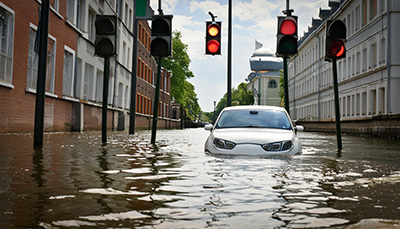Flooding can cause significant damage to your car, and the situation can be overwhelming if your vehicle has been submerged in water. However, taking the right steps as soon as possible can help minimize the damage and determine whether the car is salvageable. Here’s what to do if your car has been submerged in flood water.

1. Do Not Start the Car
The first thing to remember is not to start the car. Attempting to start a vehicle that’s been in floodwater can lead to severe engine damage, especially if water has entered the engine or electrical systems. Even if the car looks dry, moisture can wreak havoc on these sensitive components.
2. Assess the Water Level
Before you take further action, it’s essential to assess how much of the vehicle was submerged:
- If the water reached only the floorboards: Damage may be minimal, but still requires inspection.
- If water entered the engine or reached the dashboard: The car could face more significant damage, including electrical issues and potential total loss.
The deeper the water, the more likely the vehicle’s vital systems have been compromised.
3. Disconnect the Battery
Floodwater and electricity don’t mix well. To prevent any short circuits, fires, or further damage, disconnect the car battery. Doing this will help safeguard the electrical system until the vehicle can be fully inspected.
4. Remove Water and Dry Out the Car
After disconnecting the battery, try to remove as much water as possible. You can start by:
- Bailing out standing water using a bucket or a wet-dry vacuum.
- Removing the seats, floor mats, and carpeting. Allow them to dry separately, as these materials can retain moisture and lead to mold growth.
- Opening the doors and windows to allow airflow, helping with the drying process.
5. Inspect and Dry the Engine Components
If the water was high enough to affect the engine, you’ll need a more thorough inspection. This includes:
- Checking the oil dipstick for water contamination. If the oil looks milky, it’s a sign that water has mixed with the oil.
- Inspecting the air filter. A waterlogged filter could indicate water entering the engine, and the filter should be replaced.
- Draining the fuel tank if water has infiltrated the fuel system.
You may need a professional mechanic to help with these tasks.
6. Assess the Electrical System
Floodwater can severely damage a vehicle’s electrical components, including sensors, wiring, and the battery. These are often the most expensive repairs in flood-damaged cars. After drying out the car, you’ll need to have a mechanic check the entire system. Problems with the electrical system can cause intermittent issues down the line, even after apparent repairs.
7. Check for Mechanical Damage
Flooding can also affect the car’s brake system, transmission, and steering components. Have a professional check for signs of rust, corrosion, or any mechanical failure that could make the car unsafe to drive.
8. Contact Your Insurance Company
Flood damage is typically covered under comprehensive auto insurance, so you’ll want to contact your insurer as soon as possible. Be prepared to provide details about the extent of the flooding, any immediate steps you’ve taken, and any damage assessments.
9. Decide Whether to Repair or Replace the Car
After assessing the damage, you may need to decide whether it’s worth repairing the car or if it’s time to consider a replacement. If the damage is extensive, the cost of repairs may exceed the value of the vehicle. In this case, the car may be considered a total loss by your insurance company.
10. Prevent Future Flood Damage
If you live in an area prone to flooding, consider steps to protect your vehicle in the future. Some ideas include:
- Parking in elevated areas to avoid low spots where water can accumulate.
- Investing in flood insurance for your vehicle.
- Sealing your garage to reduce the likelihood of floodwater entering.
Final Thoughts
Dealing with a car that’s been submerged in floodwater can be challenging, but taking immediate and careful action is essential. Whether you decide to repair or replace the car, always prioritize safety and consult with professionals to assess the full extent of the damage.
Lim’s Auto Body is a full service auto body and mechanical repair shop locally owned and operated in Largo, Florida. For more information, go to our web site www.limsautobody.com or call (727) 422-3232.
